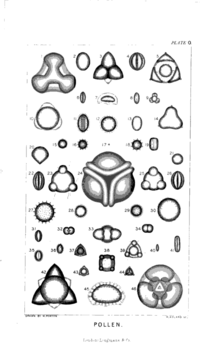Mungo Ponton

Mungo Ponton FRS (20 November 1801 – 3 August 1880) was a Scottish inventor who in 1839 created a method of permanent photography based on potassium dichromate.
Private Life

Mungo Ponton was a farmer's son, born and raised in Edinburgh. He became a legal apprentice and was admitted to the Society of Writers to the Signet, a legal fraternity, on 8 December 1825. He married Helen Scott Campbell on 24 June 1830 and the couple had seven children.
In the 1830s Ponton was listed as living at 30 Melville Street, a large new terraced townhouse in Edinburgh's west end, presumably the family's home.[1] His first wife died on 7 August 1842 and on 7 November 1843 he married his second wife, Margaret Ponton (possibly related), with whom he had a son. Ponton suffered a breakdown around 1845 and moved to Bristol, England for its milder climate. He married his third wife, Jean McLean, on 1 August 1871.
Ponton died at his home in Clifton, Bristol on 3 August 1880.[2]
Inventor

On 20 June 1834, Ponton became a Fellow of the Royal Society of Edinburgh. In 1838, the Society of Arts for Scotland awarded Ponton the silver medal for his contributions to the development of the electrical telegraph.
In 1839, while experimenting with an early photographic process published that year by Henry Fox Talbot, Ponton discovered the light-sensitising effect of potassium dichromate.[4] He presented his findings to the Society of Arts for Scotland on 29 May. Ponton did not attempt to patent his photographic process and published his findings in the Edinburgh New Philosophical Journal. Others experimented with his discovery, including Talbot, Edmond Becquerel, Alphonse Poitevin, and John Pouncey, some of whom patented their photographic techniques.[2] Dichromate sensitisation provided the basis for the carbon print and gum bichromate photographic processes, as well as some photoresists used in the printing industry and other industrial applications.
Ponton continued to work on photography and in 1845 the Society again awarded him a silver medal for his process for measuring the hourly variation in temperature on photographic paper. That year he also developed a variation on the calotype process to allow shorter exposure times.[2]
Bibliography
- The Great Architect; as Manifested in the Material Universe (1866)
- Earthquakes and Volcanoes: Their History, Phenomena, and Probable Causes (1868)
- The Beginning: Its When and Its How (1871)
- Glimpses of the Future Life (1873)
- Songs of the Soul: Philosophical Moral and Devotional (1877)
References
- ↑ http://digital.nls.uk/directories/browse/pageturner.cfm?id=83401407&mode=transcription
- 1 2 3 Simpson, Roddy (2008). "Ponton, Mungo (1801–1880)". In John Hannavy. Encyclopedia of Nineteenth-century Photography. vol. 1. CRC Press. pp. 1146–7. ISBN 978-0-415-97235-2.
- ↑ Ponton. F.R.S.E., Mungo (1871). "Plate O". The Beginning: Its When and Its How. London: Longmans, Green, and Co. Retrieved 2009-04-05.
- ↑ Solbert, Oscar N.; Newhall, Beaumont; Card, James G., eds. (March 1952). "Mungo Ponton (1802-1880)" (PDF). Image. Rochester, N.Y.: International Museum of Photography at George Eastman House Inc. 1 (3): 3–4. Retrieved 19 June 2014.